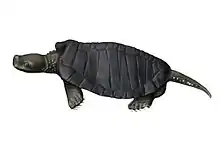| Testudinata Temporal range: Late Triassic – Holocene, Possible Early and Middle Triassic records in the form of fossil tracks[1] | |
|---|---|
 | |
| Skeleton of Proganochelys quenstedti, American Museum of Natural History | |
| Scientific classification | |
| Domain: | Eukaryota |
| Kingdom: | Animalia |
| Phylum: | Chordata |
| Class: | Reptilia |
| Clade: | Pantestudines |
| Clade: | Testudinata Klein, 1760[2] |
| Subgroups[3] | |
| |
Testudinata is the group of all tetrapods with a true turtle shell. It includes both modern turtles (Testudines) and many of their extinct, shelled relatives (stem-turtles), though excluding Odontochelys and Eorhynchochelys, which are placed in the more inclusive Pantestudines.
History
Though it was first coined as the group containing turtles by Jacob Theodor Klein in 1760, it was first defined in the modern sense by Joyce and colleagues in 2004.[2][5] While the ancestral condition for the clade is thought to be terrestrial, members of the subclade Mesochelydia, which contains almost all known testudinatans from the Jurassic onwards, are thought to be ancestrally aquatic.[6]
Classification
The cladogram below follows an analysis by Jérémy Anquetin in 2012.[5]
| ||||||||||||||||||||||||||||||||||||||||||||||||||||||||||||||||||||||||||||||||||||||||||||||
References
- ↑ Asher J. Lichtig; Spencer G. Lucas; Hendrik Klein & David M. Lovelace (2018). "Triassic turtle tracks and the origin of turtles". Historical Biology: An International Journal of Paleobiology. 30 (8): 1112–1122. doi:10.1080/08912963.2017.1339037. S2CID 133893011.
- 1 2 Joyce, Walter G.; Parham, James F. & Gauthier, Jacques Armand (2004). "Developing a protocol for the conversion of rank-based taxon names to phylogenetically defined clade names, as exemplified by turtles" (PDF). Journal of Paleontology. 78 (5): 989–1013. doi:10.1666/0022-3360(2004)078<0989:DAPFTC>2.0.CO;2. S2CID 15078337.
- ↑ Sterli, Juliana; Martínez, Ricardo N.; Cerda, Ignacio A. & Apaldetti, Cecilia (6 August 2020). "Appearances can be deceptive: bizarre shell microanatomy and histology in a new Triassic turtle (Testudinata) from Argentina at the dawn of turtles". Papers in Palaeontology. 7 (2): 1097–1132. doi:10.1002/spp2.1334. S2CID 225515560.
- ↑ Gaffney, Eugene S. & Kitching, James William (1995). "The morphology and relationships of Australochelys, an early Jurassic turtle from South Africa". American Museum Novitates (3130): 1–29. hdl:2246/3666.
- 1 2 Anquetin, J. R. M. (2012). "Reassessment of the phylogenetic interrelationships of basal turtles (Testudinata)". Journal of Systematic Palaeontology. 10: 3–45. doi:10.1080/14772019.2011.558928. S2CID 85295987.
- ↑ Sterli, Juliana; de la Fuente, Marcelo S.; Rougier, Guillermo W. (2018-07-04). "New remains of Condorchelys antiqua (Testudinata) from the Early-Middle Jurassic of Patagonia: anatomy, phylogeny, and paedomorphosis in the early evolution of turtles". Journal of Vertebrate Paleontology. 38 (4): (1)–(17). doi:10.1080/02724634.2018.1480112. ISSN 0272-4634. S2CID 109556104.

